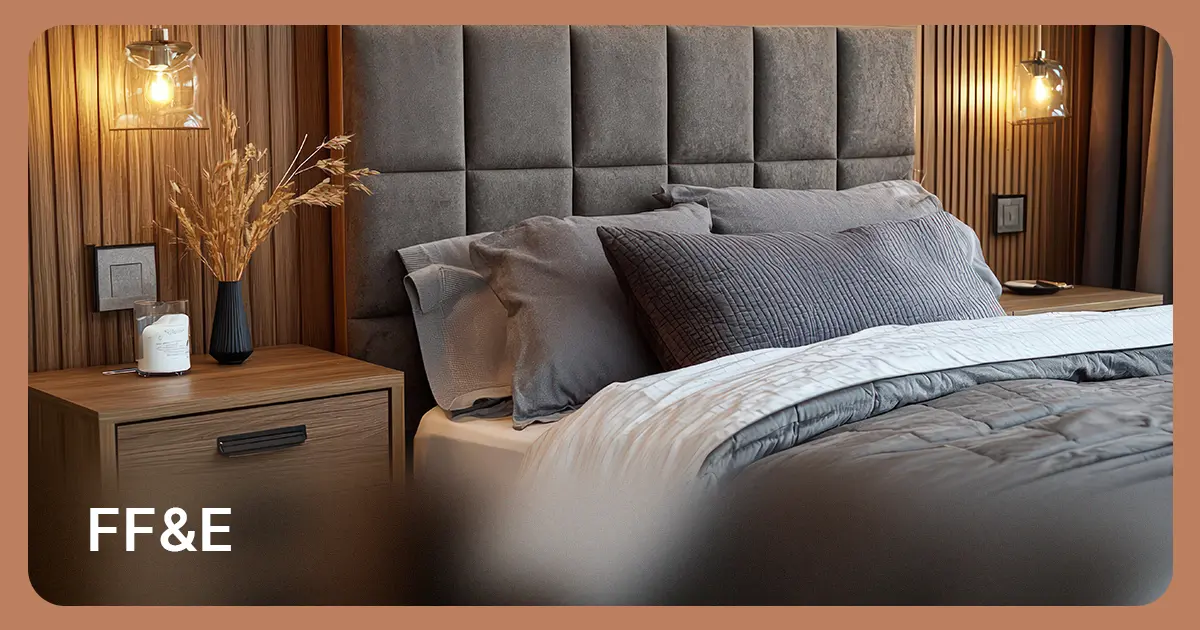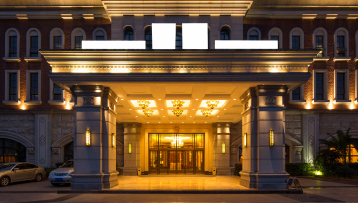Understanding ff&e procurement, is essential for anyone involved in interior design, architecture, or the hospitality industry.
These elements are essential in transforming spaces into custom environments, serving as the backbone of interior design and playing a pivotal role in branding.
From luxury hotels to cozy cafes, the right mix of FF&E can create an attractive atmosphere that is in line with the brand’s identity and resonates with its audience.
With the development of the FF&E market in Saudi Arabia, driven by Vision 2030 and the increase in hospitality projects, the demand for high-quality, culturally compatible furnishings is growing.
What is FF&E?

FF & E includes components that are not permanently attached to the building, allowing them to be easily removed or replaced.
And although it mainly focuses on furniture, fixtures and equipment, FF&E can also include finishes and other decorative elements. Here is a breakdown of the different components:
Furniture
Furniture is an essential component of FF&E, and includes a wide range of elements that serve different functions. These items include sofas, chairs, beds, tables, desks, wardrobes, and bookshelves.
Each piece is designed to sit, store or place other objects, the choice of furniture plays a vital role in determining its character and ease of use.
Whether you opt for sleek, modern designs or vintage traditional pieces, furniture within the FF & E category should reflect both the intended use of the space and the overall design theme.
Fixtures
Fixtures, which are an essential part of FF & E, refer to the attached functional elements. These elements include lighting fixtures, wall mounts, countertops, and doors.
Although they are installed, the fittings can still be removed or replaced without changing the basic design of the building. The choice of compositions is pivotal in shaping the atmosphere and usefulness of the space.
Equipment
The equipment, part of the FF&E class, includes technological and operational systems within the premises. This includes items such as appliances, computers, phones, fans, and wires.
The equipment is an integral part of the functionality of the environment, ensuring that it meets the operational needs and expectations of the user.
In a hotel, for example, equipment such as air conditioning units and kitchen utensils are essential for the convenience of guests and the efficiency of service. Similarly, in an office environment, computers and telecommunication systems are vital to everyday operations.
Finishes
Finishes, within the framework of FF&E, refer to aesthetic features that cover surfaces and contribute significantly to the look and feel of the space.
These include paint, tiles, wallpaper, carpets, hardwood floors and marble. Finishes play a crucial role in determining the atmosphere and character of the environment. It is the finishing touches that bring the design vision to life, affecting both aesthetic appeal and space functionality.
Additional Items
Additional items in the FF&E category include decorative accessories that enhance the ambiance of the space and add distinction.
These include works of art, bedding, carpets, pillows, lamps and plants. Although they are not necessary for the basic function of the space, these elements are essential to create a comfortable and attractive environment.
They allow designers to infuse personality and style, transforming public spaces into unique settings that resonate with guests.
Why is FF&E important?
FF&E (Furniture, Fixtures and Equipment) is essential in determining the style and atmosphere of any space, be it residential or commercial.
These elements transform the site into a meaningful environment, and design the experience to reflect the desired atmosphere and purpose. In homes, FF&E options can transform a simple structure into a warm and personal living space.
In business, they shape customer perceptions, influencing whether the hotel feels luxurious, the bar looks fashionable, or the retail store displays warmth and comfort. In addition to aesthetics, ff&e procurement plays a strategic role in the brand. The right combination of elements helps build a company’s brand identity, align with marketing efforts and clarify its image.
Learn More About: hospitality solutions
How is the FF&E market in Saudi Arabia evolving?

Since 2016, the FF&E market in Saudi Arabia has undergone a profound transformation, driven by the ambitious Vision 2030 initiative and the boom in hospitality ventures.
This includes luxury resorts. These projects have spurred a significant demand for high-quality, culturally appropriate FF&E. Accordingly there is an increasing involvement of domestic manufacturers, which reduces dependence on global products.
This transformation not only supports the local economy, but also fosters a blend of traditional and contemporary design elements that reflect Saudi Arabia’s rich cultural heritage.
In addition, there is a growing focus on sustainable materials and local sources, in line with global trends towards environmental responsibility.
The Saudization initiative is reshaping the market by engaging more Saudi nationals in key sectors, including hospitality, manufacturing, and design. This evolving landscape presents both opportunities and challenges, driving innovation and promoting sustainability in the FF&E industry.
Hotel FF&E and OS&E procurement strategies
A hotel FF&E (Furniture, Fixtures & Equipment) and OS&E (Operating Supplies & Equipment) procurement strategy is a comprehensive plan ensuring the successful delivery of all required furnishings and equipment within a defined budget and timeline.
This process starts with a thorough review of the project’s scope, financial constraints, design vision, and quality standards.
The strategy then progresses to detailed specifications for all FF&E items chosen by the interior designers, aligned with the client’s brief and the hotel’s overall design concept.
Key considerations include local climate, cultural nuances, and environmental conditions to ensure materials and designs are appropriate for the region.
The procurement strategy also involves meticulous scheduling and coordination to ensure timely delivery and installation. Additionally, quality control, supplier diversity, and sustainable practices are crucial aspects.
You can Look at our guide Here: FF&E and OS&E in Hospitality interior Design
Biggest challenges facing FF&E procurement firms in Saudi Arabia? and how GHS solves it?

FF&E purchasing companies in Saudi Arabia face many challenges, especially with the country’s booming hotel-building activity.
Managing complex logistics for international sourcing and navigating local customs and import systems are significant obstacles.
In addition, ensuring consistent quality control across a variety of suppliers and handling volatile materials and shipping costs adds layers of complexity. The integration of environmentally friendly and sustainable practices into the procurement process is also increasingly important.
GHS addresses these challenges by leveraging its extensive network and experience in the region. They simplify logistics and sourcing by collaborating closely with trusted suppliers, both locally and internationally, ensuring that quality standards are consistently met.
GHS also emphasizes sustainable practices by prioritizing environmentally friendly materials and supporting local manufacturers. Their expertise helps mitigate delays and cost fluctuations, providing customers with reliable and efficient purchasing solutions.
Through tailor-made strategies, GHS ensures projects are completed on time and within budget, while maintaining high standards of quality and sustainability.
GHS – Your FF&E Procurement Partner in Saudi Arabia
GHS stands out as a leading partner in FF&E procurement in Saudi Arabia, offering a combination of expertise, reliability and commitment to client success. With a deep understanding of the local and global market.
GHS provides customized purchasing solutions that match the unique needs of each customer. Their comprehensive services encompass every stage of the procurement process, from initial planning and budgeting to sourcing, quality control and installation.
By fostering strong relationships with local manufacturers, GHS supports the Saudi economy and ensures that culturally relevant design elements are integrated into projects.
Sustainability is at the forefront of their approach, as it prioritizes environmentally friendly materials and practices. This dedication to environmental responsibility underscores their commitment to the future of the industry.
Conclusion
In conclusion, ff&e procurement is a cornerstone of interior design, playing a vital role in both the aesthetic and functional aspects of a space.
From defining the atmosphere to reinforcing brand identity, the right FF&E elements are crucial for creating environments that resonate with users and support business goals.
In Saudi Arabia, the FF&E market is evolving rapidly, driven by Vision 2030 and an expanding hospitality sector.
This growth presents both opportunities and challenges for procurement firms. Companies like GHS are at the forefront, addressing these challenges with expertise and a commitment to sustainability.
By leveraging local manufacturing and eco-friendly practices, GHS not only supports the local economy but also aligns with global trends toward environmental responsibility.
As the industry continues to develop, successful FF&E procurement will require a balanced approach that considers cultural relevance, sustainability, and strategic planning. With the right partners, businesses can confidently navigate this dynamic landscape.
FAQ
What does FF&E stand for?
FF&E stands for Furniture, Fixtures, and Equipment. These are essential components of interior design that can be easily removed or replaced, unlike structural elements.
Why is FF&E important in interior design?
FF&E elements set the tone and atmosphere of a space, enhance functionality, and contribute to brand identity. They are crucial for creating environments that resonate with users and fulfill business objectives.
How is the FF&E market evolving in Saudi Arabia?
Driven by Vision 2030 and the hospitality boom, the Saudi FF&E market is focusing on high-quality, culturally aligned, and sustainable products. Local manufacturers are increasingly involved in this evolution.
What are the challenges in FF&E procurement?
Challenges include complex logistics, quality control, fluctuating costs, and the integration of sustainable practices. Navigating these requires expertise and strategic planning.
How does GHS assist with FF&E procurement?
GHS offers tailored solutions, leveraging local and global networks to streamline procurement processes, ensuring quality and sustainability while supporting local economic growth.



